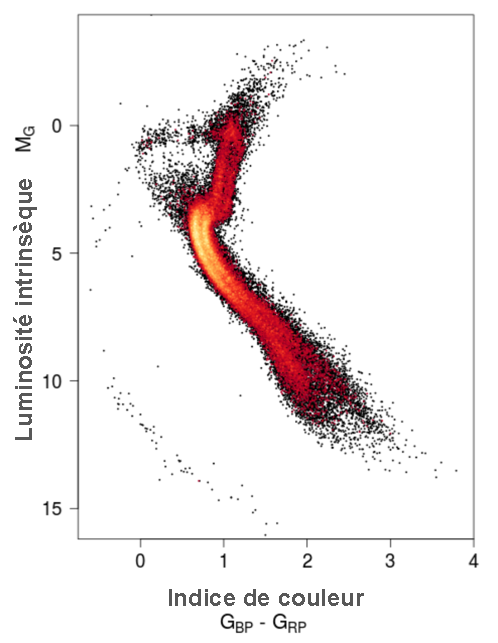1️⃣ Fossil remains of an ancient collision
One of Gaia’s key achievements has been to measure the distances of over a billion stars, making it possible in particular to estimate the intrinsic luminosities of relatively rare objects and position them in a color-luminosity diagram.
The color-luminosity diagram of stars at high velocities (over 200 km/s) revealed a surprise : the stars are distributed according to a double sequence [Gaia collaboration, Babusiaux et al., 2018].

Diagramme "couleur-luminosité" des étoiles à grandes vitesses.
|
The sequence on the right is made up of stars from the Milky Way’s primitive stellar disk, over 9 billion years old.
Gaia data have shown that the orbits of the stars making up the left-hand sequence are almost completely radial, taking some of these stars a long way from the center of the Galaxy.
These characteristics, together with the study of their chemical composition, have led to the conclusion that these stars are the fossil remains of a galaxy that merged with our own [Belokurov et al, 2018, Haywood et al., 2018, Helmi et al., 2018] 9 to 10 billion years ago.
______
2️⃣ The disc of the Milky Way heckled in the past
Theoretical models suggest that when small galaxies merged with our own, the disk of the Milky Way must have undergone profound transformations, and its shape must have changed significantly. In particular, the disk thickened.
Fossilized traces of these changes have been found by coupling the distances, proper motions and radial velocities of stars in the second Gaia catalog with their chemical compositions.
The accompanying figure shows that stars with a sufficiently small iron content have significantly more varied rotational speeds than metal-rich stars.
Some of these stars even rotate in the opposite direction to the majority of stars in the galactic disk. This is the trace we’ve been looking for. These stars, which show a peculiar rotation, constitute the part of the disk most strongly disturbed by past mergers.
This has enabled us to date this important episode of galaxy mergers to around 9 billion years ago [Di Matteo et al 2019].
______
3️⃣ Young stars in the halo ?
The disk of the Galaxy is surrounded by a spherical structure of stars, called a halo. To identify these stars, we can use their velocities, as they are generally faster than we are. But we still need to know their speed.
Since the second Gaia catalog, this has been the case for several million stars, so it is now easy to select many stars from the halo.
With one of the 8 m telescopes in Chile, we were able to observe a group of halo stars, measure their physical properties, including their iron abundance, and deduce their ages.
While, according to theory, the majority of them are old, unexpectedly, some appear "young" (a few billion years old after all) [Caffau et al., 2020].
Several explanations are currently being considered.
Their youth may only be apparent. Formed by the coalescence of two old stars, they would have observational properties similar to those of younger stars.
But these stars could also be really young. In this case, they would be a sign that our Galaxy has recently merged with smaller galaxies.
______
4️⃣ Newly arrived dwarf galaxies ?
In the past, galaxies merged with our Galaxy, helping to shape it as it is today. The latest data from Gaia allow us to trace the history of mergers in our Galaxy, via the relationship between an object’s orbital energy and the epoch in which it entered our Galaxy’s halo.
The orbital energies of the dwarf galaxies close to our Galaxy are much greater than those of the Sagittarius dwarf galaxy, which entered the halo 5-6 billion years ago.
This would imply that most of these dwarf galaxies arrived less than 3 billion years ago [Hammer et al., 2023]. Consequently, they would have recently lost their gas during their fall, in a highly destructive process described in the accompanying figure, which places them out of dynamical equilibrium and would call into question their dark matter content [Wang et al., 2024 ; Hammer et al., 2024].
| About this chapter : Authors : Piercarlo Bonifacio, Elisabetta Caffau, Paola Di Matteo, François Hammer, Misha Haywood Paris Observatory laboratories : GEPI Articles presenting the results :
|



